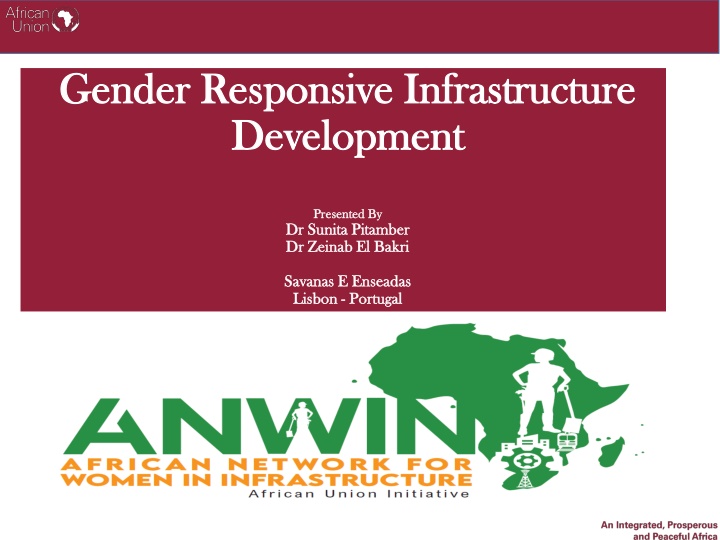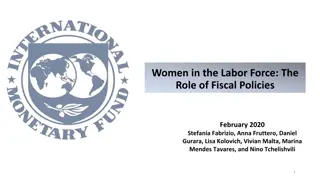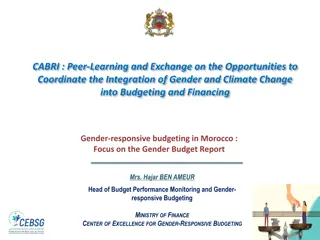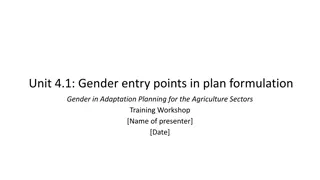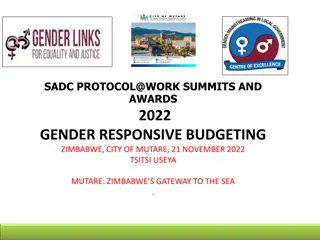Gender Responsive Infrastructure Development in Lisbon, Portugal
Explore the initiatives and discussions surrounding gender responsive infrastructure development presented by Dr. Sunita Pitamber and Dr. Zeinab El Bakri in Lisbon, Portugal. Learn about the risks of gender-blind infrastructure and the proposed agenda for Agenda 2063. Discover how PIDA promotes gender responsive infrastructure development in alignment with AU's Gender Equality and Women's Empowerment Strategy.
Download Presentation

Please find below an Image/Link to download the presentation.
The content on the website is provided AS IS for your information and personal use only. It may not be sold, licensed, or shared on other websites without obtaining consent from the author.If you encounter any issues during the download, it is possible that the publisher has removed the file from their server.
You are allowed to download the files provided on this website for personal or commercial use, subject to the condition that they are used lawfully. All files are the property of their respective owners.
The content on the website is provided AS IS for your information and personal use only. It may not be sold, licensed, or shared on other websites without obtaining consent from the author.
E N D
Presentation Transcript
Gender Responsive Infrastructure Gender Responsive Infrastructure Development Development Presented By Presented By Dr Sunita Pitamber Dr Sunita Pitamber Dr Zeinab El Bakri Dr Zeinab El Bakri Savanas E Savanas E Enseadas Lisbon Lisbon - - Portugal Enseadas Portugal
Facts Stephanie Kowlek Invented the bullet proof fibre now protects police and soldiers around the world which all
Gender Responsive Infrastructure Development Proposed Agenda TIME (GMT) AGENDA ITEM Risks to Agenda 2063 from gender-blind infrastructure: Outlining the Problems and issues of Women s Reduced Participation and Exclusion from the Infrastructure Sector 10:00 TO 10:15 10:15 TO 10:35 Introduction the GRID: the need for well-defined gender- mainstreaming guidelines for infrastructure practitioners 10:35 TO 11:05 A step-by-step overview the GRID 11:05 TO 11:25 Overview of the Policy Brief: beyond gender-neutrality in infrastructure Q&A Moderated by PIDA Coordinator 11:25 TO 12:00
Gender Responsive Infrastructure Development Gender blind infrastructure risks reducing the achievement of Agenda 2063 Vision
PIDA Promotes Gender Responsive Infrastructure Development The Agenda 2063: Aspiration 1: Undertake all actions necessary to achieve continent-wide poverty reduction, sustainable development and inclusive growth. Aspiration 2: Outline the need to promote and develop critical sectors and drivers of economic growth such as continental infrastructure development. Aspiration 6: Reiterated and provided a clear emphasis on the need to promote women s economic empowerment as follows: An Africa whose development is people-driven, relying on the potential of African people, especially its women and youth, and caring for children .
PIDA Promotes Gender Responsive Infrastructure Development The AU Gender Equality and Women s Empowerment Strategy prioritises The SDGs: Besides Goal #5, women s participation affects all other Goals PIDA partners are strongly committed to ensuring that investments in PIDA projects and all other infrastructure projects in AU Member States are gender- responsive April 2019: Second Ordinary Session of the African Union (AU) Specialized Technical Committee on Transport, Transcontinental and Interregional Infrastructure, Energy and Tourism November 2019: African Network for Women in Infrastructure (ANWiN) Launched Government representatives and partners at PIDA Week declare support for the ANWIN
Womens participation in infrastructure development Infrastructure development is not gender neutral; Infrastructure affects women and men differently, due to how they use infrastructure; Economic Empowerment Time Gendered Poverty For infrastructure to be truly sustainable its benefits must be gender inclusive; Violence against women and girls Mobility Gender responsive infrastructure can contribute to widening women s economic opportunities and contribute to gender equality Discriminatory social norms and practices
Risks of Gender Blind Infrastructure development in Africa Opportunities Challenges Yet the infrastructure gap in Africa stands at USD 170 billion Challenge of jobs, food security, and infrastructure needs Risk of localized conflict and neighborhood effect of fragility can lead to pressure on urban infrastructure and services Insufficient gender responsive focus under PIDA PAP1 Capacity to focus on women s participation in PIDA supported projects at RECs requires strengthening Sustainable integration of women s participation in infrastructure development 92 % of SDGs depend on availability of infrastructure Africa will each year add 25 million people to its workforce Rapid urbanization and improved infrastructure can increase Africa s consumer spending which was around US$680 billion (2017) and projected to increase to USD 2.2 trillion by 2030 Women make up more than half of the projected consumer spending PIDA PAP 2 is has integrated gender into the infrastructure development cycle
Risks of Gender Blind Infrastructure development in Africa Changing Perceptions Women and men have different needs and uses of infrastructure Missed Opportunities Women s equal economic participation can increase Africa s GDP by USD 316 Billion by 2025. Africa s GDP can increase by USD 14 Billion by increasing digital access for women Women make up approximately 70% of cross-border traders in Africa, most in informal sector. While 2.5 million new engineers and technicians are required in SSA alone to meet SDGs: Women represent only 7% to 12% of engineering students in Africa E.g.:Only 10% of female engineering students in South Africa and 8% in Kenya join the workforce after graduation Infrastructure is perceived as a sector for men due to the existence of heavy machinery and inputs Lack of female role model in the industry National Policies not encouraging women to enter this field Addressing Risks Gender Based Violence and sexual exploitation of girls Poor long-term sustainability of infrastructure and its Operations and Maintenance aspects
Advantages of Gender Responsive Infrastructure development in Africa: Some examples Kenya Last Mile Connectivity Project Conducted a gender analysis and stakeholder consultation These findings informed the design of the infrastructure especially the location of the Transformers Leading to increasing the number of households connected including female headed households Led to reduced cost of connection per household Reduced women s dependency on kerosene and wood Improving women s overall economic opportunities and health Benin: Solar Market Gardens Solar-powered drip irrigation systems Led to increase women s income Improved food security for their families Paid for expenditures including school fees and medical treatment. Forum for African Women Educationalists (FAWE). Implemented in 13 African Countries to increase the number of girls accessing STEM and pursuing engineering disciplines
Gender Responsive Infrastructure Development The Gender Responsive Infrastructure Development (GRID) guidelines The need for well-defined gender- mainstreaming guidelines for infrastructure practitioners
The Goal and Objectives of GRID guidelines The AUC and AUDA have committed to addressing gender equality through the Program for Infrastructure Development in Africa (PIDA) PAP2. The overall aim of the PIDA GRID Guidelines is to provide practical guidance to Member States (MS) and Regional Economic Communities (RECs) including all PIDA partners involved in infrastructure project planning, design and implementation; The specific objectives of the GRID-Guidelines are to: Support MS, REC focal points (and other stakeholders) in ensuring gender- responsive planning, designing, implementing, monitoring and evaluating of infrastructure projects Promote sustainable infrastructure development through effective gender analysis and mainstreaming in infrastructure development interventions, and Showcase the potential impact and benefits to MS of gender-responsive infrastructure development.
Mainstreaming Gender Throughout the PIDA Project cycle Gender Equality Policies / Gender Data and Analysis / Stakeholders Gender-Responsive Procurement Actions / Gender Mainstreaming in Project Monitoring & Evaluation (M&E) S3B: S0: S2A: S3A: S1: S2B: S4A: S4B: Transaction Support & Financial Close S4C: Enabling Environment & Needs Assessment Pre- Feasibili ty Project Structurin g Project Definition Feasibili ty Tenderi ng Constructi on Operation Gender Responsive Selection Criteria Process Gender Mainstreaming in Project Identification and Analysis: S0 -> S3A
Users of the GRID Guidelines The users of the GRID Guidelines are expected to be, but are not limited to: PIDA coordinators in Member States and RECs Respective Ministry of Gender/ Women (as applicable in MS) Experts in infrastructure line ministries and agencies Experts involved in Feasibility studies and Environmental and Social Assessments Financing agencies Civil Society Private sector
GRID Guidelines Gender Mainstreaming in Project Identification and Analysis Existence of national laws which ensure gender-responsive actions in infrastructure sectors Public agency assigned to assess policy compliance with gender-responsive legislation. Bodies responsible for gender equality have demonstrated effectiveness and requisite power implementing their mandates. Bodies responsible for gender equality are well resourced (in terms of budget, staff, meeting rooms, etc.). Bodies responsible for gender equality have cultivated relationships with the national women s machinery, civil society organizations, the private sector, the media and others. Demonstrated positive impact on gender equality. Existence of gaps in gender training, mainstreaming policy, and affirmative action (e.g., targets for recruitment). Gender balance in stakeholder groups and implementing agencies
Gender Responsive Infrastructure Development Screening Criteria in the InCorrA Screening Criteria: Each PIDA PAP 2 project will propose procurement related actions that could increase women s opportunities to participate in the infrastructure value chain. Screening methodology: The project under consideration will be screened to focus on increased participation of women in the infrastructure value chain as a result of proposed procurement actions. The project design may choose to include all the six procurement related actions proposed or it may propose that a combination of these actions are taken into consideration while providing explanation for their suitability within the proposed action design The proposed scoring and weighting of the criteria can be further clarified and strengthened when the project design team adds explanations on how the proposed action will have the desired output/ outcome.
Gender Responsive Infrastructure Development Screening Criteria in the InCorrA Gender Responsive Infrastructure Planning and Implementation Scoring Gender Responsive Infrastructure Action Proposed Score Project includes between zero or one procurement related action proposed in the screening methodology to support women s participation in the infrastructure value chain. Project includes two procurement related actions proposed in the screening methodology to support women s participation in the infrastructure value chain. Project includes three procurement related actions proposed in the screening methodology to support women s participation in the infrastructure value chain. Project includes four procurement related actions proposed in the screening methodology to support women s participation in the infrastructure value chain. 1 1 2 2 3 3 4 4 Project includes five or more procurement related actions proposed in the screening methodology to support women s participation in the infrastructure value chain. 5 5
Gender Responsive Infrastructure Development Screening Criteria in the InCorrA Some gender sensitive procurement related actions that a project can propose are (but not limited to): a) Actions that may support preferential procurement of women-owned SMEs or gender-certified businesses as subcontractors, b) Capacity building of contractors and state institutions in methodologies for increasing women s participation; c) Training women business owners to get appropriate national certification; d) Evaluation criteria in the bidding documents that are drafted with the aim to encourage female suppliers or vendors, e) Establish standards for bidders to demonstrate track-records with regard to promoting gender-inclusive activities; and f) Establishing gender responsive monitoring and reporting systems. Benchmarking and monitoring are key in assuring that the proposed impact of this feature is achieved.
GRID Guidelines Gender Mainstreaming in Project Design and Implementation Ensure benefits to women, such as new training, employment and income opportunities, or increased access to new markets, education and/ or health facilities, additional security for women and girls against violence, are integrated in the project design Ensure that all the proposed gender-responsive features, whether in the infrastructure design and/ or impact, are properly captured as needed in the relevant sections of the tender document Include detailed costs of proposed gender specific actions in the project financing plan Ensure the Project Implementation Unit and relevant line ministries continue to monitor and report on gender mainstreaming efforts
GRID Guidelines Gender Mainstreaming in Monitoring and Evaluation Ensure sex disaggregated data collection and reporting systems are established Establish realistic targets that aim to advance gender equality. Separate targets for males and females and by relevant age groups. Check assumptions: Would an intervention targeted to vulnerable children and families benefit all families equally? Ensure that the project results matrix/log frame clearly outlines the gender specific activities at all levels. That is, project objectives, inputs, outputs, and outcomes. The actions in the log frame should be clear, measurable, and show clear alignment to sustainable outcomes. In addition, each activity must be clearly costed within the overall project budget. Determine whether the project objectives and specific components effectively address gender issues.
Gender Responsive Infrastructure Development: End of Section on GRID
Gender Responsive Infrastructure Development Policy Priorities for Gender Responsive Infrastructure The need for well-defined gender- mainstreaming policies for infrastructure policy makers
The PIDA Policy Engagement Policy harmonisation for gender issues in the infrastructure sector To ensure gender-related goals and women's empowerment on the continent The PIDA Steering Committee (PIDA-SC), RECs, and Member States committed to To identify the key policy constraints within the infrastructure institutional architecture and enabling environment that constrain women s participation as users and contributors to the infrastructure life cycle in Africa; and To present priority policy priorities for the consideration of the PIDA SC to be further recommended for discussion and consideration by MS, RECs and other relevant stakeholders in the policy realm under the PAP2. The PIDA Policy Engagement Member states policy design and decision makers RECs PIDA Steering Committee members Stakeholders: civil society, private sector, academia, research institutions, Think Tanks Targeted Audience (not limited to) Specific objectives of Policy Brief
Gender-Responsive Infrastructure Planning & Enabling Environment Promote the implementation of national, regional and continental policy, legal and regulatory frameworks for gender-responsive infrastructure Provide for the different infrastructure needs of both women and men Build capacity of decision-makers and practitioners to ensure gender sensitivity and responsiveness Systematically collect and analyse gender-disaggregated data and build evidence and context on gender infrastructure needs at national, regional, and local levels
Gender-Responsive Financing Ensure national and regional gender-responsive infrastructure policy objectives are properly financed and resourced
Gender-Responsive Supply Chain and Procurement Promote gender responsive procurement processes by increasing women s participation and women-owned businesses in the supply and value chain. Identify and promote supporting policies for public and private procurement processes at national, regional and continental levels
Gender-Responsive Employment in the Infrastructure Sector Attract and retain more women as employees at different levels of the infrastructure sector through differentiated positive actions starting with infrastructure-relevant education and capacity building and going all the way to gender sensitive employment policies
Thank you Merci Obrigado
